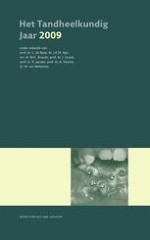Abstract
Unilaterale condylaire hyperactiviteit (UCH) is een term voor een ziektebeeld dat gekenmerkt wordt door een asymmetrische ontwikkeling van de mandibula en als gevolg daarvan, soms ook van de maxilla. Deze mandibulaire (of bimaxillaire) asymmetrie is gebaseerd op een enkelzijdig toegenomen of opnieuw opgetreden groei van een van de condyli mandibulae). UCH is de meest voorkomende postnatale groeiabnormaliteit van het temporomandibu- laire gewricht (TMG), maar desondanks zeldzaam. Dit is de reden dat UCH meestal niet of laat herkend wordt door (tand)artsen. Condylaire hyperactiviteit vertoont geen duidelijke epidemiologische verscheidenheid op basis van geslacht of ras. De gemiddelde leeftijd van UCH-patiënten is tussen de twintig en dertig jaar. De (mandibulaire) asymmetrie kan zich geleidelijk (gedurende vele jaren) ontwikkelen, maar kan zich ook binnen enkele weken of maanden openbaren.
